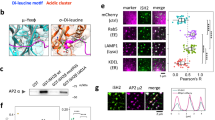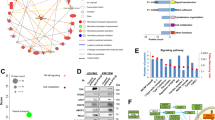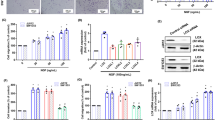Abstract
A potential role for 1-oleoyl-sn-glycero-3-phosphate or lysophosphatidic acid (LPA) and sphingosine-1-phosphate (S1P) in the regulation of malignant diseases has been widely considered. In this study, we found that in transformed astroglial cells, the expression profile of lysophospholipid receptor mRNA and the action modes of LPA and S1P on cell motility were changed: there was a change in the acquisition of the ability of LPA to stimulate cell migration and a change in the migratory response to S1P from stimulation through S1P1 to inhibition through S1P2. LPA-induced cell migration was almost completely inhibited by either pertussis toxin, LPA1 receptor antagonists including Ki16425 (3-(4-[4-([1-(2-chlorophenyl)ethoxy]carbonyl amino)-3-methyl-5-isoxazolyl] benzylsulfonyl)propanoic acid) or an inhibitor of phosphatidylinositol 3-kinase (PI3K) wortmannin. The LPA-induced action was also suppressed, although incompletely, by several specific inhibitors for intracellular signaling pathways including Rac1, Cdc42, p38 mitogen-activated protein kinase (p38MAPK) and c-Jun terminal kinase (JNK), but not extracellular signal-regulated kinase. Nearly complete inhibition of migration response to LPA, however, required simultaneous inhibition of both the p38MAPK and JNK pathways. Inhibition of Rac1 suppressed JNK but not p38MAPK, while the activity of p38MAPK was abolished by a dominant-negative form of Cdc42. These findings suggest that, in glioma cells, the PI3K/Cdc42/p38MAPK and PI3K/Rac1/JNK pathways are equally important for LPA1 receptor-mediated migration.
This is a preview of subscription content, access via your institution
Access options
Subscribe to this journal
Receive 50 print issues and online access
$259.00 per year
only $5.18 per issue
Buy this article
- Purchase on Springer Link
- Instant access to full article PDF
Prices may be subject to local taxes which are calculated during checkout









Similar content being viewed by others
Abbreviations
- LPA:
-
1-oleoyl-sn-glycero-3-phosphate or lysophosphatidic acid
- S1P:
-
sphingosine-1-phosphate
- PI3K:
-
phosphatidylinositol 3-kinase
- MAP kinase:
-
mitogen-activated protein kinase
- p38MAPK:
-
p38MAP kinase
- p38-DN:
-
dominant-negative mutant for p38MAPK
- JNK:
-
c-Jun terminal kinase
- JIP1-JBD:
-
JNK-binding domain of JNK-interacting protein-1
- ERK:
-
extracellular signal-regulated kinase
- MEK:
-
ERK kinase
- T17NRac1:
-
dominant-negative mutant for Rac1
- T17NCdc42:
-
dominant-negative mutant for Cdc42
- PDGF:
-
platelet-derived growth factor
- EGF:
-
epidermal growth factor
- DGPP 8:0:
-
dioctylglycerol pyrophosphate
- G-protein:
-
GTP-binding regulatory protein
- PTX:
-
pertussis toxin
- GAPDH:
-
glyceraldehyde-3-phosphate dehydrogenase
- GFP:
-
green fluorescent protein
References
Bennett BL, Sasaki DT, Murray BW, O'Leary EC, Sakata ST, Xu W, Leisten JC, Motiwala A, Pierce S, Satoh Y, Bhagwat SS, Manning AM and Anderson DW . (2001). Proc. Natl. Acad. Sci. USA, 98, 13681–13686.
Bian D, Su S, Mahanivong C, Cheng RK, Han Q, Pan ZK, Sun P and Huang S . (2004). Cancer Res., 64, 4209–4217.
Burridge K and Wennerberg K . (2004). Cell, 116, 167–179.
Cara DC, Kaur J, Forster M, McCafferty DM and Kubes P . (2001). J. Immunol., 167, 6552–6558.
Chandrasekar N, Mohanam S, Gujrati M, Olivero WC, Dinh DH and Rao JS . (2003). Oncogene, 22, 392–400.
Cunnick JM, Dorsey JF, Standley T, Turkson J, Kraker AJ, Fry DW, Jove R and Wu J . (1998). J. Biol. Chem., 273, 14468–14475.
Daub H, Wallasch C, Lankenau A, Herrlich A and Ullrich A . (1997). EMBO J., 16, 7032–7044.
Edlund S, Landstrom M, Heldin CH and Aspenstrom P . (2002). Mol. Cell. Biol., 13, 902–914.
Fischer DJ, Nusser N, Virag T, Yokoyama K, Wang DA, Baker DL, Bautista D, Parrill AL and Tigyi G . (2001). Mol. Pharmacol., 60, 776–784.
Gschwind A, Prenzel N and Ullrich A . (2002). Cancer Res., 62, 6329–6336.
Hama K, Aoki J, Fukaya M, Kishi Y, Sakai T, Suzuki R, Ohta H, Yamori T, Watanabe M, Chun J and Arai H . (2004). J. Biol. Chem., 279, 17634–17639.
Heise CE, Santos WL, Schreihofer AM, Heasley BH, Mukhin YV, Macdonald TL and Lynch KR . (2001). Mol. Pharmacol., 60, 1173–1180.
Hsia DA, Mitra SK, Hauck CR, Streblow DN, Nelson JA, Ilic D, Huang S, Li E, Nemerow GR, Leng J, Spencer KS, Cheresh DA and Schlaepfer DD . (2003). J. Cell Biol., 160, 753–767.
Huang C, Rajfur Z, Borchers C, Schaller MD and Jacobson K . (2003). Nature, 424, 219–223.
Imamura F, Horai T, Mukai M, Shinkai K, Sawada M and Akedo H . (1993). Biochem. Biophys. Res. Commun., 193, 497–503.
Ishiuchi S, Tsuzuki K, Yoshida Y, Yamada N, Hagimura N, Okado H, Miwa A, Kurihara H, Nakazato Y, Tamura M, Sasaki T and Ozawa S . (2002). Nat. Med., 8, 971–978.
Ishizuka T, Okajima F, Ishiwara M, Iizuka K, Ichimonji I, Kawata T, Tsukagoshi H, Dobashi K, Nakazawa T and Mori M . (2001). J. Immunol., 167, 2298–2304.
Kawauchi T, Chihama K, Nabeshima Y and Hoshino M . (2003). EMBO J., 22, 4190–4201.
Kimura T, Sato K, Malchinkhuu E, Tomura H, Tamama K, Kuwabara A, Murakami M and Okajima F . (2003). Arterioscler. Thromb. Vasc. Biol., 23, 1283–1288.
Kon J, Sato K, Watanabe T, Tomura H, Kuwabara A, Kimura T, Tamama K, Ishizuka T, Murata N, Kanda T, Kobayashi I, Ohta H, Ui M and Okajima F . (1999). J. Biol. Chem., 274, 23940–23947.
Lamalice L, Houle F, Jourdan G and Huot J . (2004). Oncogene, 23, 434–445.
Liu Y, Wada R, Yamashita T, Mi Y, Deng CX, Hobson JP, Rosenfeldt HM, Nava VE, Chae SS, Lee MJ, Liu CH, Hla T, Spiegel S and Proia RL . (2000). J. Clin. Invest., 106, 951–961.
Malchinkhuu E, Sato K, Muraki T, Ishikawa K, Kuwabara A and Okajima F . (2003). Biochem. J., 370, 817–827.
Manning Jr TJ, Parker JC and Sontheimer H . (2000). Cell Motil. Cytoskeleton, 45, 185–199.
Maruyama Y, Nishida M, Sugimoto Y, Tanabe S, Turner JH, Kozasa T, Wada T, Nagao T and Kurose H . (2002). Circ. Res., 91, 961–969.
Matsumoto T, Yokote K, Tamura K, Takemoto M, Ueno H, Saito Y and Mori S . (1999). J. Biol. Chem., 274, 13954–13960.
Mills GB and Moolenaar WH . (2003). Nat. Rev. Cancer, 3, 582–591.
Nobes CD and Hall A . (1999). J. Cell Biol., 144, 1235–1244.
Ohta H, Sato K, Murata N, Damirin A, Malchinkhuu E, Kon J, Kimura T, Tobo M, Yamazaki Y, Watanabe T, Yagi M, Sato M, Suzuki R, Murooka H, Sakai T, Nishitoba T, Im DS, Nochi H, Tamoto K, Tomura H and Okajima F . (2003). Mol. Pharmacol., 64, 994–1005.
Okamoto H, Takuwa N, Yokomizo T, Sugimoto N, Sakurada S, Shigematsu H and Takuwa Y . (2000). Mol. Cell. Biol., 20, 9247–9261.
Pebay A, Toutant M, Premont J, Calvo CF, Venance L, Cordier J, Glowinski J and Tence M . (2001). Eur. J. Neurosci., 13, 2067–2076.
Pichon S, Bryckaert M and Berrou E . (2004). J. Cell Sci., 117, 2569–2577.
Raingeaud J, Gupta S, Rogers JS, Dickens M, Han J, Ulevitch RJ and Davis RJ . (1995). J. Biol. Chem., 270, 7420–7426.
Rao TS, Lariosa-Willingham KD, Lin FF, Palfreyman EL, Yu N, Chun J and Webb M . (2003). Brain Res., 990, 182–194.
Rousseau S, Houle F, Landry J and Huot J . (1997). Oncogene, 15, 2169–2177.
Sato K, Ishikawa K, Ui M and Okajima F . (1999a). Brain Res. Mol. Brain Res., 74, 182–189.
Sato K, Tomura H, Igarashi Y, Ui M and Okajima F . (1999b). Mol. Pharmacol., 55, 126–133.
Sato K, Ui M and Okajima F . (2000). Brain Res. Mol. Brain Res., 85, 151–160.
Schafer B, Gschwind A and Ullrich A . (2004). Oncogene, 23, 991–999.
Schulte KM, Beyer A, Kohrer K, Oberhauser S and Roher HD . (2001). Int. J. Cancer, 92, 249–256.
Shi G, Wu Y, Zhang J and Wu J . (2003). J. Immunol., 171, 3407–3414.
Stahle M, Veit C, Bachfischer U, Schierling K, Skripczynski B, Hall A, Gierschik P and Giehl K . (2003). J. Cell Sci., 116, 3835–3846.
Stam JC, Michiels F, van der Kammen RA, Moolenaar WH and Collard JG . (1998). EMBO J., 17, 4066–4074.
Steiner MR, Urso JR, Klein J and Steiner SM . (2002). Biochim. Biophys. Acta, 1582, 154–160.
Tokumura A, Majima E, Kariya Y, Tominaga K, Kogure K, Yasuda K and Fukuzawa K . (2002). J. Biol. Chem., 277, 39436–39442.
Umezu-Goto M, Kishi Y, Taira A, Hama K, Dohmae N, Takio K, Yamori T, Mills GB, Inoue K, Aoki J and Arai H . (2002). J. Cell Biol., 158, 227–233.
Van Brocklyn JR, Young N and Roof R . (2003). Cancer Lett., 199, 53–60.
Vandenberg SR . (1992). J. Neuropathol. Exp. Neurol., 51, 644–657.
Van Leeuwen FN, Olivo C, Grivell S, Giepmans BN, Collard JG and Moolenaar WH . (2003). J. Biol. Chem., 278, 400–406.
Wang F, Van Brocklyn JR, Hobson JP, Movafagh S, Zukowska-Grojec Z, Milstien S and Spiegel S . (1999). J. Biol. Chem., 274, 35343–35350.
Westermann AM, Havik E, Postma FR, Beijnen JH, Dalesio O, Moolenaar WH and Rodenhuis S . (1998). Ann. Oncol., 9, 437–442.
Xia Y, Makris C, Su B, Li E, Yang J, Nemerow GR and Karin M . (2000). Proc. Natl. Acad. Sci. USA, 97, 5243–5248.
Xie Y, Gibbs TC, Mukhin YV and Meier KE . (2002). J. Biol. Chem., 277, 32516–32526.
Xu Y, Fang XJ, Casey G and Mills GB . (1995). Biochem. J., 309, 933–940.
Yamada T, Sato K, Komachi M, Malchinkhuu E, Tobo M, Kimura T, Kuwabara A, Yanagita Y, Ikeya T, Tanahashi Y, Ogawa T, Ohwada S, Morishita Y, Ohta H, Im DS, Tamoto K, Tomura H and Okajima F . (2004). J. Biol. Chem., 279, 6595–6605.
Acknowledgements
We are grateful to Professor Kevin R Lynch of University of Virginia School of Medicine and Dr Hideo Ohta of Kirin Brewery Co, Ltd for generous gift of VPC12249 and Ki16425, respectively. We thank Professor Yoh Takuwa of Kanazawa University Graduate School of Medicine for generous gift of human S1P2 cDNA. We also thank Ms Chisuko Uchiyama, Ms Mayumi Komachi and Mr Masayuki Tobo for technical assistance. This work was supported by a Grant-in-Aid for scientific research from the Japan Society for the Promotion of Science, a grant of the 21st Century COE Program from the Ministry of Education, Culture, Sports, Science and Technology of Japan and grants from ONO Medical Research Foundation, The Nakatomi Foundation and Uehara Memorial Foundation.
Author information
Authors and Affiliations
Corresponding author
Additional information
Supplementary Information accompanies the paper on the Oncogene website (http://www.nature.com/onc)
Supplementary information
Rights and permissions
About this article
Cite this article
Malchinkhuu, E., Sato, K., Horiuchi, Y. et al. Role of p38 mitogen-activated kinase and c-Jun terminal kinase in migration response to lysophosphatidic acid and sphingosine-1-phosphate in glioma cells. Oncogene 24, 6676–6688 (2005). https://doi.org/10.1038/sj.onc.1208805
Received:
Revised:
Accepted:
Published:
Issue Date:
DOI: https://doi.org/10.1038/sj.onc.1208805
Keywords
This article is cited by
-
The Agpat4/LPA axis in colorectal cancer cells regulates antitumor responses via p38/p65 signaling in macrophages
Signal Transduction and Targeted Therapy (2020)
-
Lysophosphatidic acid induces YAP-promoted proliferation of human corneal endothelial cells via PI3K and ROCK pathways
Molecular Therapy - Methods & Clinical Development (2015)
-
Sphingosine 1-Phosphate to p38 Signaling via S1P1 Receptor and Gαi/o Evokes Augmentation of Capsaicin-Induced Ionic Currents in Mouse Sensory Neurons
Molecular Pain (2014)
-
p38 MAPK inhibitors attenuate pro-inflammatory cytokine production and the invasiveness of human U251 glioblastoma cells
Journal of Neuro-Oncology (2012)
-
BRAF and RAS oncogenes regulate Rho GTPase pathways to mediate migration and invasion properties in human colon cancer cells: a comparative study
Molecular Cancer (2011)



